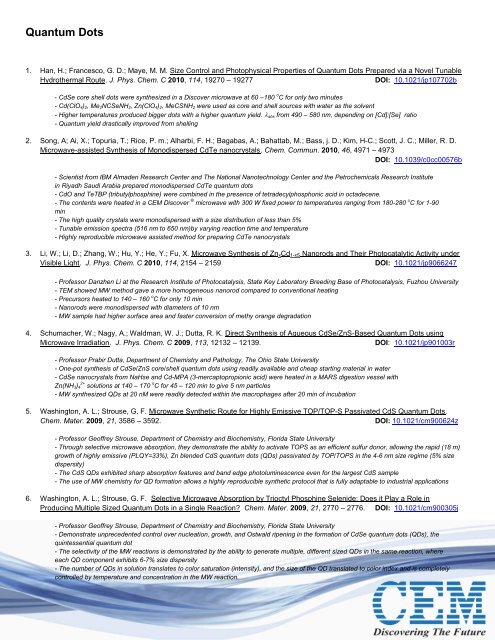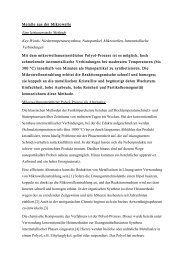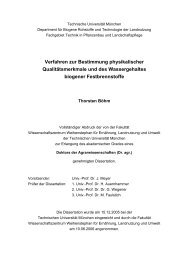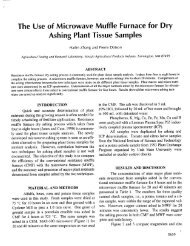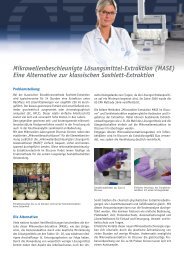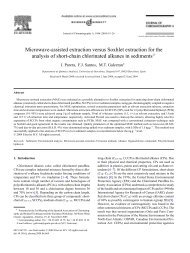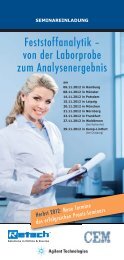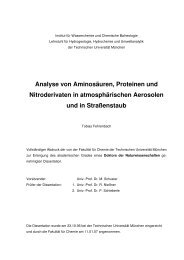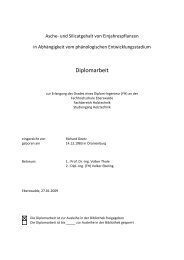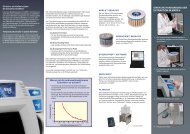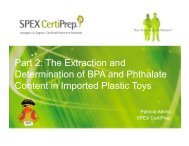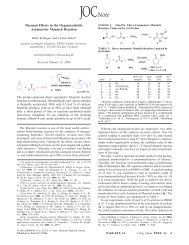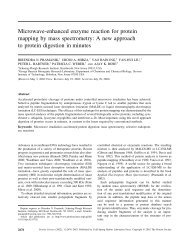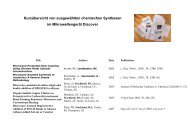Quantum Dots - Cem
Quantum Dots - Cem
Quantum Dots - Cem
You also want an ePaper? Increase the reach of your titles
YUMPU automatically turns print PDFs into web optimized ePapers that Google loves.
<strong>Quantum</strong> <strong>Dots</strong><br />
1. Han, H.; Francesco, G. D.; Maye, M. M. Size Control and Photophysical Properties of <strong>Quantum</strong> <strong>Dots</strong> Prepared via a Novel Tunable<br />
Hydrothermal Route. J. Phys. Chem. C 2010, 114, 19270 – 19277 DOI: 10.1021/jp107702b<br />
- CdSe core shell dots were synthesized in a Discover microwave at 60 –180 o C for only two minutes<br />
- Cd(ClO4)2, Me2NCSeNH2, Zn(ClO4)2, MeCSNH2 were used as core and shell sources with water as the solvent<br />
- Higher temperatures produced bigger dots with a higher quantum yield. �abs from 490 – 580 nm, depending on [Cd]:[Se] ratio<br />
- <strong>Quantum</strong> yield drastically improved from shelling<br />
2. Song, A; Ai, X.; Topuria, T.; Rice, P. m.; Alharbi, F. H.; Bagabas, A.; Bahattab, M.; Bass, j. D.; Kim, H-C.; Scott, J. C.; Miller, R. D.<br />
Microwave-assisted Synthesis of Monodispersed CdTe nanocrystals. Chem. Commun. 2010, 46, 4971 – 4973<br />
DOI: 10.1039/c0cc00576b<br />
- Scientist from IBM Almaden Research Center and The National Nanotechnology Center and the Petrochemicals Research Institute<br />
in Riyadh Saudi Arabia prepared monodispersed CdTe quantum dots<br />
- CdO and TeTBP (tributylphosphine) were combined in the presence of tetradecylphosphonic acid in octadecene.<br />
- The contents were heated in a CEM Discover ® microwave with 300 W fixed power to temperatures ranging from 180-280 o C for 1-90<br />
min<br />
- The high quality crystals were monodispersed with a size distribution of less than 5%<br />
- Tunable emission spectra (516 nm to 650 nm)by varying reaction time and temperature<br />
- Highly reproducible microwave assisted method for preparing CdTe nanocrystals<br />
3. Li, W.; Li, D.; Zhang, W.; Hu, Y.; He, Y.; Fu, X. Microwave Synthesis of ZnxCd1-xS Nanorods and Their Photocatalytic Activity under<br />
Visible Light. J. Phys. Chem. C 2010, 114, 2154 – 2159 DOI: 10.1021/jp9066247<br />
- Professor Danzhen Li at the Research Institute of Photocatalysis, State Key Laboratory Breeding Base of Photocatalysis, Fuzhou University<br />
- TEM showed MW method gave a more homogeneous nanorod compared to conventional heating<br />
- Precursors heated to 140 – 160 o C for only 10 min<br />
- Nanorods were monodispersed with diameters of 10 nm<br />
- MW sample had higher surface area and faster conversion of methy orange degradation<br />
4. Schumacher, W.; Nagy, A.; Waldman, W. J.; Dutta, R. K. Direct Synthesis of Aqueous CdSe/ZnS-Based <strong>Quantum</strong> <strong>Dots</strong> using<br />
Microwave Irradiation. J. Phys. Chem. C 2009, 113, 12132 – 12139. DOI: 10.1021/jp901003r<br />
- Professor Prabir Dutta, Department of Chemistry and Pathology, The Ohio State University<br />
- One-pot synthesis of CdSe/ZnS core/shell quantum dots using readily available and cheap starting material in water<br />
- CdSe nanocrystals from NaHse and Cd-MPA (3-mercaptopropionic acid) were heated in a MARS digestion vessel with<br />
Zn(NH3)4 2+ solutions at 140 – 170 o C for 45 – 120 min to give 5 nm particles<br />
- MW synthesized QDs at 20 nM were readily detected within the macrophages after 20 min of incubation<br />
5. Washington, A. L.; Strouse, G. F. Microwave Synthetic Route for Highly Emissive TOP/TOP-S Passivated CdS <strong>Quantum</strong> <strong>Dots</strong>.<br />
Chem. Mater. 2009, 21, 3586 – 3592. DOI: 10.1021/cm900624z<br />
- Professor Geoffrey Strouse, Department of Chemistry and Biochemistry, Florida State University<br />
- Through selective microwave absorption, they demonstrate the ability to activate TOPS as an efficient sulfur donor, allowing the rapid (18 m)<br />
growth of highly emissive (PLQY=33%), Zn blended CdS quantum dots (QDs) passivated by TOP/TOPS in the 4-6 nm size regime (5% size<br />
dispersity)<br />
- The CdS QDs exhibited sharp absorption features and band edge photoluminescence even for the largest CdS sample<br />
- The use of MW chemistry for QD formation allows a highly reproducible synthetic protocol that is fully adaptable to industrial applications<br />
6. Washington, A. L.; Strouse, G. F. Selective Microwave Absorption by Trioctyl Phosphine Selenide: Does it Play a Role in<br />
Producing Multiple Sized <strong>Quantum</strong> <strong>Dots</strong> in a Single Reaction? Chem. Mater. 2009, 21, 2770 – 2776. DOI: 10.1021/cm900305j<br />
- Professor Geoffrey Strouse, Department of Chemistry and Biochemistry, Florida State University<br />
- Demonstrate unprecedented control over nucleation, growth, and Ostwald ripening in the formation of CdSe quantum dots (QDs), the<br />
quintessential quantum dot<br />
- The selectivity of the MW reactions is demonstrated by the ability to generate multiple, different sized QDs in the same reaction, where<br />
each QD component exhibits 6-7% size dispersity<br />
- The number of QDs in solution translates to color saturation (intensity), and the size of the QD translated to color index and is completely<br />
controlled by temperature and concentration in the MW reaction.
- The ability to repetitively generate nucleation and growth events in which a specific color index with defined color saturation is isolated from<br />
a single reaction offers potential for preparing mixed QD compositions for applications in optical barcoding, white light emitting diodes (LEDs),<br />
and photovoltaics (PVs).<br />
7. He, Y. et al. Microwave Synthesis of Water-Dispersed CdTe/CdS/ZnS Core-Shell-Shell <strong>Quantum</strong> <strong>Dots</strong> with Excellent Photostability<br />
and Biocompatibility. Adv. Mater. 2008, 20, 3416 – 3421. DOI: 10.1002/adma.200701166<br />
- Professor Wei Huang and Lian-Hui Wang at the Institute of Advanced Materials, Nanjing University of Posts and Telecommunication and<br />
Laboratory of Advanced Materials, Fudan University<br />
- Synthesized CdTe/CdS/ZnS (this is a QD with a CdTe center, encased in a layer of CdS, followed by an outer layer of ZnS) QDs using MW<br />
irradiation<br />
- CdTe MW, 100 o C, 1 min<br />
- CdTe/CdS MW, 100 o C, 5 min<br />
- CdTe/CdS/ZnS, MW, 60 o C, 5 min. Final size of 3.4 – 4.5 nm.<br />
- <strong>Quantum</strong> Yield increased drastically from CdTe (30%) to CdTe/CdS/ZnS (80%)<br />
- This was the first example of water dispersed QDs that are made in water -which was assisted by MW irradiation<br />
8. Roy, M. D.; Herzing, A. A.; Lacerda, S. H.; Becker, M. L. Emission-Tunable Microwave Synthesis of Highly Luminescent Water<br />
Solube CdSe/ZnS <strong>Quantum</strong> <strong>Dots</strong>. Chem. Commun. 2008, 2106 – 2108. DOI: 10.1039/b800060c<br />
- Dr. Matthew Becker Polymers Division and Surface and Microanalysis Science Division, National Institute of Standards and Technology<br />
- Water soluble CdSe/ZnS nanoparticles with emission maxima from 511 nm to 596 nm and quantum efficiencies ranging from 11% to 28%<br />
were synthesized using MW irradiation<br />
- Particle size controlled by heating times. Reactions were run at lower temperatures (145 – 150 o C) under ambient atmosphere with shorter<br />
reaction times when compared to conventional reactions<br />
- This approach offered a great deal of control of particle size and particles were very monodispersed<br />
9. Lovingood, D. D.; Strouse, G. F. Microwave Induced In-Situ Active Ion Etching of Growing InP nanocrystals. Nano Lett. 2008, 8,<br />
3394 – 3397. DOI: 10.1021/nl802075j<br />
- Professor Geoffrey Strouse, Florida State University, Department of Chemistry<br />
- Used MW irradiation and fluorinated ionic liquids to etch InP nanoparticles. Conventional procedure required HF. This technique eliminates<br />
the need for HF, making it much safer and more practical<br />
- 280 o C, 300 W, times of 70 s to 20 min<br />
10. Washington, A. L.; Strouse, G. F. Microwave Synthesis of CdSe and CdTe Nanocrystals in Nonabsorbing Alkanes. J. Am. Chem.<br />
Soc. 2008, 130, 8916 – 8922. DOI: 10.1021/ja711115r<br />
- Professor Geoffrey Strouse, Florida State University, Department of Chemistry<br />
- Synthesis of CdSe and CdTe quantum dots<br />
- Were found to be temperature, time, and power dependent in the presence of an Ionic Liquid and minohexadecane (strong MW<br />
absorbing solvents)<br />
- Temperature and time dependent in non MW absorbing solvent<br />
- By varying the reaction temperature, time, power, or a combination of both, Strouse and co-workers were successful in controlling particles<br />
size and quantum yields<br />
- Typical diameters were 2.5 – 5 nm, depending on power, temperature, and time<br />
- Typical Temperatures were 180 – 280 o C, time ranging from 30 – 600 sec, power 67 – 400 W<br />
- Higher temperatures and longer reaction times lead to larger particles with lower quantum yields<br />
- The higher the power the faster the ramp to temperature-which resulted in a higher quality QD.<br />
- Cooling at the end of this reaction played a crucial role in QD size. Slow cooling from the reaction temperature to ambient conditions<br />
resulted in larger size dispersity<br />
11. Gerbec, J. A.; Magana, D.; Washington, A.; Strouse G. F. Microwave-Enhanced Reaction Rates for Nanoparticle Synthesis. J. Am.<br />
Chem. Soc. 2005, 127, 15791 – 15800. DOI: 10.1021/ja052463g<br />
- See above reference<br />
12. Firth, A. V.; Tao, Y.; Wang, D.; Ding, J.; Bensebaa, F. Microwave Assisted Synthesis of CdSe Nanocrystals for the Straightforward<br />
Integration into Composite Photovoltaic Devices. J. Mater. Chem. 2005, 15, 4367 – 4372 DOI: 10.1039/b505891k<br />
- Dr. Andrea Firth, National Research Council, Ottawa Canada<br />
- A preparative route for a nanocrystalline CdSe/polymer nanocomposite was developed with microwave irradiation.<br />
- Microwave assisted synthesis is used to initiate the reaction of relatively safe, inexpensive and air stable precursors.<br />
- Particles size may be varied from 20 A° to 60 A° in diameter. The CdSe nanocrystals show near band-edge photoemission, are crystalline
and may be incorporated into a poly(9,9-dioctylfluorene-2,7-diylalt-9-octylcarbazole-3,6-diyl) copolymer.<br />
- Polymer/CdSe composite can be directly cast, without complicated work-up, for the preparation of photovoltaic devices.<br />
Inorganic Nanomaterial<br />
13. Yu, M.; Funke, H. H.; Noble, R. D.; Falconer, J. L. H2 Separation Using Defect-Free, Inorganic Composite Membranes. J. Am.<br />
Chem. Soc. 2011, 133, 1748 – 1750. DOI: 10.1021/ja108681n<br />
- Professor Miao Yu, Department of Chemical and Biological Engineering, University of Colorado<br />
- Using a CEM MARS with Teflon vessels, SAPO-34 zeolite seed crystals were prepared for membrane synthesis<br />
- Molecular layer deposition (MLD) was used to deposit a thin, porous layer of alumina upon the zeolite support<br />
- Composite membranes showed much higher ability to separate H2 from N2 and CO2 than conventional SAPO-34 membranes<br />
14. Wang, H.-E.; Zheng, L.-X.; Liu, C.-P.; Liu, Y.-K.; Luan, C.-Y.; Cheng, H.; Li, Y. Y.; Martinu, L.; Zapien, J. A.; Bello, I. Rapid<br />
Microwave Synthesis of Porous TiO2 Spheres and Their Applications in Dye-Sensitized Solar Cells. J. Phys. Chem. C, 2011, 115,<br />
10419 – 10425. DOI: 10.1021/jp2011588<br />
- Professors Juan Antonio Zapien and Igor Bello, Department of Physics and Materials Science and Center of Super-Diamond and Advanced<br />
Films (COSDAF), City University of Hong Kong,<br />
- Porous TiO2 nanospheres constructed in only 10 minutes by microwave synthesis in a CEM Discover<br />
- Products displayed good morphology and better electrochemical efficiency than commercially available nanopowders<br />
15. Vernon, J. P.; Fang, Y.; Cai, Y.; Sandhage, K. H. Morphology-Preserving Conversion of a 3D Bioorganic Template into a<br />
Nanocrystalline Multicomponent Oxide Compound. Angew. Chem. Int. Ed. 2010, 49, 7765 – 7768. DOI: 10.1002/anie.201003170<br />
- Professor Kenneth H. Sandhage, School of Materials Science and Engineering, Georgia Institute of Technology<br />
- A layer -by-layer surface sol-gel process was used to convert the structure of Morpho helenor butterfly wings to BiTiO3 replicas<br />
- CEM MARS used for the final step, microwave hydrothermal conversion of anatase TiO2 to BaTiO3<br />
- The general process can be applied to microscale nanostructured bioorganic or synthetic organic templates<br />
16. Mehta, R. J.; Karthik, C.; Jiang, W.; Singh, B.; Shi, Y.; Siegel, R. W.; Borca-Tasciuc, T.; Ramanath, G. High Electrical Conductivity<br />
Antimony Selenide Nanocrystals and Assemblies. Nano Lett. 2010, 10, 4417 – 4422. DOI: 10.1021/nl1020848<br />
- Professor Ganpati Ramanath, Rensselaer Polytechnic Institute, Department of Materials Science and Engineering.<br />
- One-dimensional nanocrystals of sulfurized antimony selenide were synthesized in a rapid and scalable manner<br />
- 10 4 -10 10 times higher electrical conductivity than non-nanostructured bulk or thin film forms<br />
- Control of microwave heating times showed changes in wire morphology<br />
17. Wang, H. Q.; Nann, T. Monodisperse Upconverting Nanocrystals by MW Assisted Synthesis. ACS Nano 2009, 3, 3804 – 3808.<br />
DOI: 10.1021/nn9012093<br />
- Professor Thomas Nann, School of Chemistry, University of East Anglia, Norwich<br />
- Nanocrystals consisting of different ratios of Na, Er, Y, and Li were synthesized<br />
- A microwave assisted synthesis approach allows for the synthesis of such monodisperse and luminescent upconverting nanocrystals within<br />
5 min in a closed reaction vessel (even though the same reactants and solvents as with classical conductive heating reactions were used)<br />
- Microwave-assisted synthesis resulted in differently sized and shaped particles and provided superior reaction control. The nucleation and<br />
growth mechanism follows a La Mer scheme and can be controlled extremely accurately<br />
Addition/Correction DOI: 10.1021/nn100270n<br />
18. Baruwati, B.; Polshettiwar, V.; Varma, R. S. Glutathione Promoted Expeditious Green Synthesis of Silver Nanoparticles in Water<br />
using Microwaves. Green Chem. 2009, 11, 926 – 930. DOI: 10.1039/b902184a<br />
- Varma at the EPA developed rapid, green synthesis of Ag, Pt, Pd, and Cu nanoparticles in Glutathione (benign antioxidant)<br />
- Reaction time of 30 – 60 sec at 50 W for Ag, and 45 – 60 sec at 75 W for Pt, Pd, and Cu<br />
- Completed at very low temperatures: 40 – 60 o C. Conventional temperatures > 150 o C<br />
- Monodispersed particles of 5 – 10 nm
19. Bolink,H. J.; Cappelli, L.; Coronado, E.; Grätzel, M.; Nazeeruddin, M. K. Efficient and Stable Solid-State Light-Emitting<br />
Electrochemical Cell Using Tris(4,7-diphenyl-1,10-phenanthroline)ruthenium(II) Hexafluorophosphate. J. Am. Chem. Soc. 2006,<br />
128, 46 – 47. DOI: 10.1021/ja0565065<br />
- Professor Henk Bolink, Institute of Molecular Science at the University of Valencia<br />
- The title compound was prepared in a CEM Discover in only 5 minutes with a yield of 89% as compared to conventional reactions which can<br />
take days and generate
25. Suib, S. L. et al. Systematic Control of Particle Size in Rapid Open Vessel Microwave Synthesis of K-OMS-2 Nanofibers. J. Phys.<br />
Chem. C 2008, 112, 6786 – 6793. DOI: 10.1021/jp800672m<br />
- Professor Steven Suib, Department of Chemistry and Department of Chemical, Materials and Biomolecular Engineering. University of<br />
Connecticut<br />
- Typical reaction conditions using an oil bath require anywhere from hours to days, multiple procedures under hydrothermal and refluxing<br />
conditions, and generally have no direct control of nanoparticle size and surface area-which play a crucial role in determining the catalytic<br />
properties of the material<br />
- Developed a systematic approach to control particle size by using MW irradiation and varying the amount of co-solvent (DMSO) from 0 –<br />
50% v/v in water<br />
- Microwave irradiation formed nanofibers, ranging from 4 – 12.2 nm. These results could not be duplicated using an oil bath. No ordered<br />
nanoparticles were recovered after 90 min of reflux using conventional heating methods and poorly ordered manganese oxide with particle<br />
diameter of around 100 nm formed at room temperature. Well-formed needle-like fibers were only formed with the addition of microwave<br />
irradiation. The needle diameter was varied by changing the ratio of solvent to co-solvent<br />
26. Zhu, j-F.; Zhu, Y-J.; Ma, M-G.; Yan, L-X.; G, L. Simultaneous and Rapid Microwave Synthesis of Polyacrylamide – Metal Sulfide<br />
(Ag2S, Cu2S, HgS) Nanocomposites. J. Phys. Chem. C 2007, 111, 3920 –3926 DOI: 10.1021/jp0677851<br />
- Professor Ying-Ji Zhu at the State Key Laboratory of high Performance Ceramics and superfine Microstructures and Shanghai Institute of<br />
Ceramics, Chinese Academy of Sciences.<br />
- Fast, microwave assisted synthesis of polyacrylamide metal sulfides using metal salt, sulfur powered, and acrylamide monomer<br />
- Heated in ethylene glycol, which acted as solvent and reducing agent. Created low-cost preparation of polymeric metal sulfide nanoparticles<br />
without additional need for initiator or surfactant<br />
- Reaction run in open vessel format, samples heated to 125 o C or 190 o C for 15 – 60 min.<br />
- Took over 2 h to complete in oil bath<br />
- Overall, variable heating times, temperatures resulted in monodispersed, size control synthesis of metal sulfide nanoparticles<br />
Magnetic Metal Materials<br />
27. Yi, D. K.; Lee, S. S.; Ying, J. Y. Synthesis and Applications of Magnetic Nanocomposite Catalysts. Chem. Mater. 2006, 18, 2459 –<br />
2461. DOI: 10.1021/cm052885p<br />
- Dr. Jackie Y. Ying, Institute of Bioengineering and Nanotechnology, Singapore<br />
- Synthesis of Pd coated SiO2/Fe2O3 nanoparticles<br />
- Microwave irradiation allowed synthesis of more uniform and finer palladium particles than conventional methods<br />
- Particles showed dramatically increased catalytic ability over commercial Pd/C<br />
28. Liang, Y.-C.; Hwang, K. C.; Lo, S.-C. Solid-State Microwave-Arcing-Induced Formation and Surface Functionalization of<br />
Core/Shell Metal/Carbon Nanoparticles. Small, 2008, 4, 405 – 409. DOI: 10.1002/smll.200700808<br />
- Professor Kuo Chu Hwang, Department of Chemistry, National Tsing Hua University<br />
- Silicon pieces and ferrocene powder were arced to form Fe/C nanoparticles which could then be surface functionalized<br />
- Reactions were performed in the solid-state, and without the formation of carbon nanotubes<br />
- Similar nanoparticles could be prepared using Ni or Co metallocenes<br />
29. Amstad, E.; Gillich, T.; Bilecka, I.; Textor, M.; Reimhult E. Ultrastable Iron Oxide Nanoparticle Colloidal Suspensions using<br />
Dispersants with Catechol-Derived Anchor Groups. Nano Lett. 2009, 9, 4042 – 4048. DOI: 10.1021/nl902212q<br />
- Professor Erick Reimhult at the Laboratory of Surface Science and Technology and Laboratory for Multifunctional Mateirals, ETH Zurich<br />
- Fe(ac)2 in BnOH were heated for 3 min at 180 o C<br />
- Monodispersed 6 nm Fe3O4<br />
- Dispersants later added to stabilize iron oxide in water<br />
30. Taylor, K. M.; Rieter, W. J.; Lin, W. Manganese – Based Nanoscale Metal – Organic Frameworks for Magnetic Resonance<br />
Imaging. J. Am. Chem. Soc. 2008, 130, 14358 – 14359. DOI: 10.1021/ja803777x<br />
- Professor Weblin Lin, Department of Chemistry, University of North Carolina at Chapel Hill<br />
- There was a remarkable difference in the synthesis of Manganese Based Metal Organic Frameworks when microwave irradiation was<br />
utilized. Spiral nanorods (50 –100 nm x 1000-2000 nm) were obtained under room temperature conditions while three dimensional nanocubes<br />
(50 – 300 nm) were synthesized via microwave irradiation
- MW conditions: 120 o C for 10 min, 800 W<br />
- Nanocubes could not be duplicated under conventional conditions<br />
31. Wang W. W.; Zhu, Y. J.; Ruan, M. L. Microwave – Assisted Synthesis and Magnetic Property of Magnetite and Hematite<br />
Nanoparticles. J. Nanopart. Res. 2007, 9, 419 – 426. DOI: 10.1007/s11051-005-9051-8<br />
- Professor Ying-Jie Zhu, State Key Laboratory of High Performance Ceramics and Superfine Microstructure and the Chinese Academy of<br />
Sciences and Analysis and Testing Center for Inorganic Materials Shanghai Institute of Ceramics<br />
- MW irradiation led to �-Fe2O3 ellipsoid nanocrystals (50 x 100 nm), while conventional heating, under the same conditions, lead to irregular<br />
nanorods and particles<br />
- Conditions: 100 o C, 10 min<br />
32. Sreeja, V.; Joy, P.A. Microwave-Hydrothermal Synthesis of �-Fe2O3 Nanoparticles and their Magnetic Properties. Mater. Res. Bull.<br />
2007, 42, 1570 – 1576. DOI: 10.1016/j.materresbull.2006.11.014<br />
- Professor P.A. Joy, Physical and Materials Chemistry Division, National Chemical Laboratory.<br />
- It is shown that microwave–hydrothermal method offered a convenient, fast and single step process for the synthesis of nanoparticles of �-<br />
Fe2O3<br />
- Nanoparticles of �-Fe2O3 could be synthesized at 150 o C in short time duration of 25 min by the microwave hydrothermal method<br />
33. Nguyen, H. L.; Howard, l. E. M.; Giblin, S. R.; Tanner, B. K.; Terry, I.; Hughes, A. K.; Ross, i. M.; Serres, A.; Burckstummer, H.;<br />
Evans, J. S. O. Synthesis of Monodispersed fcc and fct FePt/FePd Nanoparticles by Microwave Irradiation. J. Mater. Chem. 2005,<br />
15, 5136 – 5143. DOI: 10.1039/b511850f<br />
- Professor John Evans, Department of Chemistry, University Science Laboratories, University of Durham, in collaboration with Department of<br />
Physics and Department of Electronic and Electrical Engineering<br />
- Monodispersed superparamagnetic fcc FePt and fct FePd nanoparticles were synthesized in short reaction times, 6 – 90 min at high<br />
temperatures (150 – 282 o C).<br />
- For maximum power, several of the reactions were run in open vessel format under inert atmosphere at 282 o C<br />
34. Katsuki, H.; Komarneni, S. Microwave-Hydrothermal Synthesis of Monodispersed Nanophase α-Fe2O3. J. Am. Ceram. Soc. 2001,<br />
84, 2313 – 2317. DOI: 10.1111/j.1151-2916.2001.tb01007.x<br />
- Dr. Hiroaki Katsuki and Professor Sridhar Komarneni at Saga Ceramics Research Laboratory and Materials Research Laboratory and<br />
Department of Agronomy, The Pennsylvania State University<br />
- “Red, spherical α-Fe2O3 particles, 50–100 nm in diameter, were formed with β-FeOOH crystals after 13 h via the C-H reaction. α-Fe2O3,<br />
100–180 nm in diameter, was preferentially formed after 24 h of treatment.... With the M-H reaction at 100°C, monodispersed α-Fe2O<br />
particles, 31 nm in diameter, were formed in 2 h without the formation of β-FeOOH.”<br />
Organic Nanostructures<br />
35. Silva, P.; Vieira, F.; Gomes, A. C.; Ananias, D.; Fernandes, J. A.; Bruno, S. M.; Soares, R.; Valente, A. A.; Rocha, J.; Paz, F. A. A.<br />
Thermal Transformation of a Layered Multi-Functional Network into a Metal-Organic Framework based on a Polymeric Organic<br />
Linker. J. Am. Chem. Soc. 2011, Just accepted DOI: 10.1021/ja205243w<br />
- Professor Filipe A. Almeida Paz, Department of Chemistry, CICECO, University of Aveiro<br />
- Layered [La(H3nmp)] was synthesized using both dynamic hydrothermal methods and microwave synthesis<br />
- Conventional reaction required 2 days at 165 o C while microwave reactions completed in only 1 minute at 140 o C<br />
- Further heating above 300 o C converted the layered solid to a three-dimensional metal organic framework (MOF)<br />
- [La(H3nmp)] MOF was shown to have excellent selectivity and reactivity as a heterogeneous catalyst in epoxide ring opening reactions<br />
36. Zhuang, G.-L.; Chen, W.-X.; Zhao, H.-X.; Kong, X.-J.; Long, L.-S.; Huang, R.-B.; Zheng, L.-S. Two Three-Dimensional 2p−3d−4f<br />
Heterometallic Frameworks Featuring a Ln6Cu24Na12 Cluster as a Node. Inorg. Chem. 2011, 50, 3843 – 3845.<br />
DOI: 10.1021/ic200077r<br />
- Professors Xiang-Jian Kong and La-Sheng Long, State Key Laboratory of Physical Chemistry of Solid Surface and Department of Chemistry,<br />
College of Chemistry and Chemical Engineering, Xiamen University<br />
- Microwave heating used to synthesize two heterometallic metal organic frameworks (MOFs) containing either Gd or Dy<br />
- Nodes of MOF feature rare copper-sodium-lanthanide nanocluster<br />
- Testing of magnetic and electrical properties performed demonstrate ferrimagnetism and proton conductivity respectively
37. Rifai, S.; Breen, C. A.; Solis, D. J.; Swager, T. M. Facile in Situ Silver Nanoparticle Formation in Insulating Porous Polymer<br />
Matrices. Chem. Mater. 2006, 18, 21 – 25. DOI: 10.1021/cm0511419<br />
- Professor Timothy M. Swager, Department of Chemistry, Massachusetts Institute of Technology<br />
- Silver/poly(aryl ether) (PAE) nanoparticles were synthesized using varied microwave pulses<br />
- Resultant structures showed good uniformity and could be synthesized in as quickly as 5 minutes<br />
- Ag/PAE particles were then incorporated into an insulating polymer matrix resulting in a “relatively uniform polymer-ion thin film”<br />
38. Wang, X.; Xia, T.; Ntim, S. A.; Ji, Z.; Meng, H.; Zhang, H.; Castranova, V.; Mitra, S.; Nel, A. E. Quantitative Techniques for<br />
Assessing and Controlling the Dispersion and Biological Effects of Multiwalled Carbon Nanotubes in Mammalian Tissue Culture<br />
Cells. ACS Nano 2010, 4, 7241 – 7252. DOI: 10.1021/nn102112b<br />
- Professor Andre E. Nel , Division of NanoMedicine, Department of Medicine, and California NanoSystems Institute,UCLA<br />
- CEM MARS used for purification and functionalization of multiwalled carbon nanotubes (MWCNT)<br />
- Modified nanotubes used to assay dispersion of MWCNT in tissue culture media<br />
- It was determined that hydrophobicity is the major factor determining agglomeration<br />
39. Dössel, L.; Gherghel, L.; Feng, X.; Müllen, K. Graphene Nanoribbons by Chemists: Nanometer-Sized, Soluble, and Defect-Free.<br />
Angew. Chem. Int. Ed. 2011, 50, 2540 – 2543. DOI: 10.1002/anie.201006593<br />
- Professor Klaus Müllen, Max-Planck-Institut für Polymerforschung<br />
- Researchers detail a bottom-up organic synthesis of defect-free graphene nanoribbons<br />
- Microwave irradiation was used to construct polymer precursors which were efficiently converted to grapheme nanoribbons by an<br />
intramolecular Scholl reaction<br />
40. Centrone, A.; Yang, Y.; Speakman, S.; Bromberg, L.; Rutledge, G. C.; Hatton, T. A. Growth of Metal – Organic Frameworks on<br />
Polymer Surfaces. J. Am. Chem. Soc. 2010, 132, 15687 – 15691 DOI: 10.1021/ja106381x<br />
- Scientist at MIT synthesized metal organic frameworks (MOFs) directly on polyacrylonitrile using microwave irradiation<br />
- Growth of MOF was studied by varying microwave irradiation time<br />
- Reagents were heated in DI water to 200 o C for 5 s to 30 min.<br />
- MOF agglomerates formed on the polymer after just 5 s of MW irradiation. The MOFs were only found on the polymer and not in the bulk<br />
solution<br />
- Provides rapid, reproducible method to coat polymer fibers with MOFs<br />
41. Lhoste, J.; Rocquefelte, X.; Adil, K.; Dessapt, R.; Jobic, S.; Leblanc, M.; Maisonneuve, V.; Bujoli-Doeuff, M. A New Organic–<br />
Inorganic Hybrid Oxyfluorotitanate [Hgua]2·(Ti5O5F12) as a Transparent UV Filter. Inorg. Chem. 2011, 50, 5671 – 5678.<br />
DOI: 10.1021/ic200407h<br />
- Prof. V. Maisonneuve and Dr. M. Bujoli-Doeuff, Faculté des Sciences et Techniques, Université du Maine and IMN, France<br />
- A unique UV absorber with the structure [Hgua]2•(Ti5O5F12) was synthesized using microwave hydrothermal synthesis<br />
- Heating materials in a CEM MARS with Teflon vessels to 190 o C for 1 hour generated the desired product efficiently<br />
- Investigations of the atomic, optical, and electrical properties show that this hybrid may have unique applications for UV shielding<br />
42. Gizdavic-Nikolaidis, M. R.; Stanisavljev, D. R.; Easteal, A. J.; Zujovic, Z. D. Microwave-Assisted Synthesis of Functionalized<br />
Polyaniline Nanostructures with Advanced Antioxidant Properties. J. Phys. Chem. C 2010, 114, 18790 – 18796.<br />
DOI: 10.1021/jp106213m<br />
- Utilized microwave irradiation to synthesize copolymers of aniline and 2-aminobenzoic acid or 20aminosulfonic acid<br />
- When compared to conventionally synthesized copolymers, MW yields were 2.5 – 3.0 times higher<br />
- MW samples were also 2.1 – 2.4 times better radical scavenger efficacy<br />
- MW times were between 5 and 10 min<br />
43. Centrone, A.; Harada, T.; Speakman, S.; Hatton, T. A. Facile Synthesis of Vanadium Metal – Organic Frameworks and their<br />
Magnetic Properties. Small 2010, 15, 1598 – 1602 DOI: 10.1002/smll.201000773<br />
- Scientist at MIT presented a microwave synthesis of MIL-47 and 6 new vanadium MOF’s<br />
- Precursors were heated to 200 o C for only 10 min<br />
- Represents a very fast and reproducible method for MOF’s
44. Economopoulos, S. P.; Pagona, G.; Yudasaka, M.; Iijima, S.; Tagmatarchis, N. Solvent-free Microwave-Assisted Bingel Reaction<br />
in Carbon Nanohorns. J. Mater. Chem. 2009, 19, 7326 – 7331. DOI: 10.1039/b910947a<br />
- Dr. Nikos Tagmatarchis at the Theoretical and Physical Chemistry Institute- National Hellenic Research Foundation (Athens, Greece) and in<br />
collaboration with the Nanotube Research Center, National Institute of Advanced Industrial Science and Technology(Higashi, Japan) and NEC<br />
Corporation(Ibaraki, Japan)<br />
- Functionalized carbon nano-horns with fluorescent linkers through Bingel reaction without solvent<br />
- MW irradiation provided a high degree of functionalization<br />
- Pulse method: 5 – 45 second of MW irradiation was used. Total reaction time of 5 min with a max temp of 120 – 140 o C<br />
- Conventional synthesis: 60 o C for 20 h<br />
45. Fujita, D.; Takahashi, A.; Sato, S.; Fujita, M. Self-Assembly of Pt(II) Spherical Complexes via Temporary Labilization of the Metal–<br />
Ligand Association in 2,2,2-Trifluoroethanol. J. Am. Chem. Soc. 2011, ASAP DOI: 10.1021/ja2059236<br />
- Professor Makoto Fujita, Department of Applied Chemistry, School of Engineering, The University of Tokyo, and CREST, Japan Science<br />
and Technology Agency<br />
- Researchers used solvent conditions and metal ion selection to control geometry and self-assembly of spherical complexes<br />
- Previous syntheses of complexes required 4h or more of reaction time under conventional conditions; microwave reactions complete in 30<br />
minutes or less<br />
46. Wang, Y.; Su, F.; Lee, J. Y.; Zhao, X. S. Crystalline Carbon Hollow Spheres, Crystalline Carbon−SnO2 Hollow Spheres, and<br />
Crystalline SnO2 Hollow Spheres: Synthesis and Performance in Reversible Li-Ion Storage. Chem. Mater. 2006, 18, 1347 – 1353.<br />
DOI: 10.1021/cm052219o<br />
- Professor Jim Yang. Lee, Department of Chemical and Biomolecular Engineering, National University of Singapore<br />
- SnO2 nanoparticles prepared with microwave heating showed uniform dispersion and no agglomeration on carbon hollow sphere surface as<br />
compared to conventional heating methods<br />
- Microwave synthesis completed in only 3 minutes; conventional heating required 3 hours<br />
- Electrochemical testing of different products demonstrated potential applications of tin composite nanostructures in Li-ion storage<br />
47. Campbell, N. L.; Clowes, R.; Ritchie, L. K.; Cooper, A. I. Rapid Microwave Synthesis and Purification of Porous Covalent Organic<br />
Frameworks. Chem. Mater. 2009, 21, 204 – 206. DOI: 10.1021/cm802981m<br />
- Professor Andrew Cooper at University of Liverpool – Dept of Chemistry and materials discovery<br />
- MW irradiation offered a convenient and rapid synthesis of covalent organic frameworks.<br />
- 200 times faster than conventional methods<br />
- Reactions were run in closed vessel and open vessel format at 100 o C, 200W<br />
- Reaction times as low as 20 min<br />
- COFs had surface area equal to or greater than conventional made COF’s and synthesized 200 times faster<br />
48. Economopoulos, S. P.; Rotas, G.; Miyata, Y.; Shinohara, H.; Tagmatarchis, N. Exfoliation and Chemical Modification Using<br />
Microwave Irradiation Affording Highly Functionalized Graphene. ACS Nano 2010, 4, 7499 – 7507. DOI: 10.1021/nn101735e<br />
- Dr.Nikos Tagmatarchis, Theoretical and Physical Chemistry Institute, National Hellenic Research Foundation<br />
- Used MW to multi-functionalize graphene<br />
- Series of electrochemical, spectroscopic, gravimetric, and thermal experiments performed to fully characterize new material<br />
49. Brunetti, F. G.; Herrero, M. A.; Munoz, J. M.; Diaz-Ortiz, A.; Alfonsi, J.; Meneghetti, M.; Prot, M.; Vazquez, E. Microwave-Induced<br />
Multiple Functionalization of Carbon Nanotubes. J. Am. Chem. Soc. 2008, 130, 8094 – 8100. DOI: 10.1021/ja801971k<br />
- Professor Maurizio Prato and Professor Ester Vazquez. Universita degli Studi di Trieste and Universidad de Castilla-La Mancha<br />
- Used MW to multi-functionalize CNTs<br />
- Conventional conditions generally require high temperatures and/or pressures, long reaction times, and organic solvents or mineral acids<br />
- MW reduced amount of organic waste, and reduced the reaction time from 5 days to 2.5 hours.<br />
- Typical temperatures for [3+2] cycloaddition step was 160 o C for 90 min (100 W), and no solvent, the reaction was done under neat<br />
conditions. Arene addition step: 80 o C,90 min (100 W) and in water<br />
50. Brunetti, F. G.; Herrero, M. A.; Munoz, J. M.; Giordani, S.; Diaz-Ortiz, A.; Filppone, S.; Ruaro, G.; Meneghetti, M.; Prot, M.;<br />
Vazquez, E. Reversible Microwave Assisted Cycloaddition of Aziridines to Carbon Nanotubes. J. Am. Chem. Soc. 2007, 129,<br />
14580 – 14581. DOI: 10.1021/ja077927k<br />
- See previous reference


